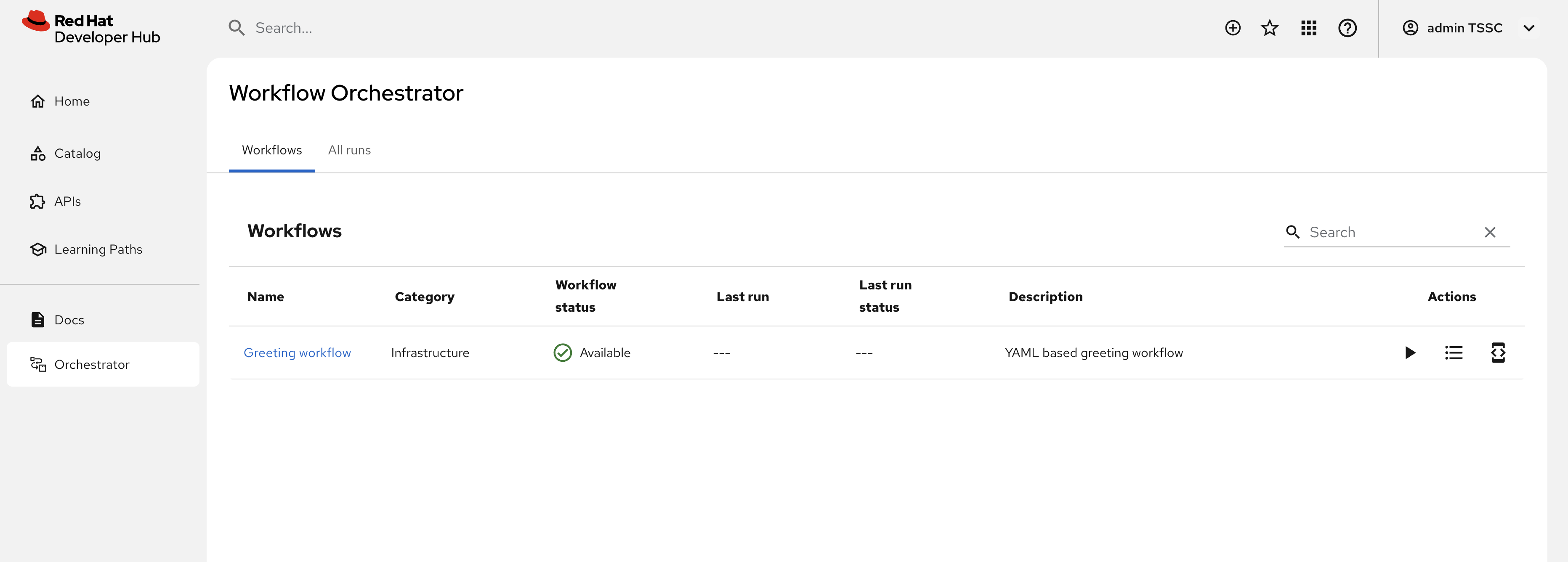Orchestrator for Red Hat Developer Hub
|
Quick Logout Links Prior to starting this module, click the following two links and make sure you log out of previous sessions to prevent errors related to performing actions as the wrong user. |
Other modules demonstrate how to use Software Templates as a means for developers to scaffold new codebases that follow organisational standards, and self-service certain aspects of their daily activities.
However, developer self-service requests might require more than what a Software Template can provide natively. For example, certain requests might require an approval, while others might involve long-running, stateful processes - this is where the Orchestrator for Red Hat Developer Hub can help. It addresses the fact that regular Software Templates are stateless "run and done" processes.
The Orchestrator feature extends Red Hat Developer Hub with support for workflows created using SonataFlow. The Orchestrator project website and documentation is available at rhdhorchestrator.io.
SonataFlow and Serverless Workflow
SonataFlow is a tool for building cloud-native workflow applications. You can use it to do the services and events orchestration and choreography - Apache KIE
SonataFlow is part of a broader ecosystem of projects within Apache KIE, including Drools, jBPM, and Kogito. Specifically, SonataFlow is an implementation of the Serverless Workflow model.
Serverless Workflow is a cloud-native workflow engine that allows teams to design, deploy and execute arbitrarily complex workflows that integrate with external systems through several mechanisms. Teams define workflows in the Serverless Workflow format, and SonataFlow will take care of the build, state management, and serverless deployment aspects for you.
The following workflow definition demonstrates functions, input validation using schema(s), and behavior modeling using state machine semantics. A workflow like this can be built and deployed on OpenShift as a Quarkus-based application container using the SonataFlow Operator.
id: greeting
version: '1.0'
specVersion: '1.0'
name: Greeting workflow
description: YAML based greeting workflow
annotations:
- "workflow-type/infrastructure"
# Workflows use schemas, in JSON Schema format, to validate inputs
dataInputSchema:
# Schemas are stored relative to the workflow source. Find all files at:
# github.com/rhdhorchestrator/serverless-workflows/blob/main/workflows/greeting/
schema: schemas/greeting.sw.input-schema.json
failOnValidationErrors: true
# Reusable logic can be defined using functions
functions:
- name: greetFunction
# Can be "rest", "rpc", "expression", or "custom"
type: custom
# If type is "rest" this would be a URL, but we're using a
# custom "sysout" functionality provided by SonataFlow
operation: sysout
- name: successResult
# Here we evaluate an expression
type: expression
# Expressions are following JSONata spec (https://jsonata.org/)
operation: '{ "result": { "message": "Greeting workflow completed successfully", "outputs":[ { "key":"Selected language", "value": .language }, { "key":"Greeting message", "value": .greeting } ] } }'
start:
stateName: ChooseOnLanguage
states:
- dataConditions:
# The language variable is part of the workflow inputs
# defined in the input schema
- condition: .language == "English"
transition:
nextState: GreetInEnglish
- condition: .language == "Spanish"
transition:
nextState: GreetInSpanish
defaultCondition:
transition:
nextState: GreetInEnglish
name: ChooseOnLanguage
type: switch
- data:
greeting: Hello from YAML Workflow
name: GreetInEnglish
transition:
nextState: GreetPerson
type: inject
- data:
greeting: Saludos desde YAML Workflow
name: GreetInSpanish
transition:
nextState: GreetPerson
type: inject
- actionMode: sequential
actions:
- actionDataFilter:
useResults: true
functionRef:
arguments:
message: .greeting
invoke: sync
refName: greetFunction
name: greetAction
- actionDataFilter:
useResults: true
functionRef:
invoke: sync
refName: successResult
name: setOutput
end:
terminate: true
name: GreetPerson
type: operation| To learn more about the workflow YAML/JSON, you can view workflow.json schema on serverlessworkflow.io. |
A VSCode Extension to assist workflow development is supported by the SonataFlow project. This extension renders a visual representation of the workflow.
SonataFlow and Orchestrator
The Orchestrator feature effectively acts as an interface between Red Hat Developer Hub and SonataFlow-powered workflows, providing a listing and the ability view and run workflows directly from Red Hat Developer Hub.
Additionally, long running workflows can integrate with the Backstage Notifications plugin, to allow users or groups to be notified of milestones in the workflow execution. This is particularly useful for long running workflows where it’s impractical for a user to wait for completion.
The following screenshot shows the prior "greeting" workflow available in the Red Hat Developer Hub UI.

